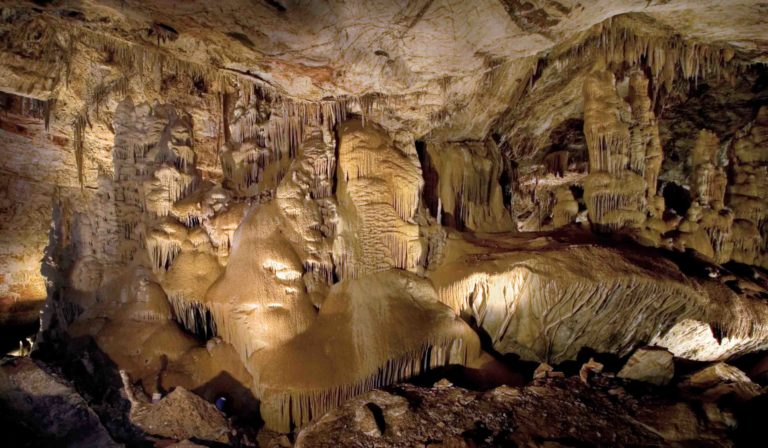
THE SCENE
One Saturday in 1974, two young men affiliated with Southern Arizona Grotto, a spelunking, or “caving,” group based in Tuscon, Arizona, were out exploring, looking for new caves near the Whetsone Mountains. Randy Tufts and Gary Tenen traveled about an hour outside of Tucson, where they were roommates at the University of Arizona.
As they often did, Tufts and Tenen carried only the minimum amount of caving equipment they needed: two miners’ hard hats with gas carbine lanterns affixed to the top, some rope, hammers and chisels, and snacks.Tufts had been introduced to spelunking by an uncle, and on this day he wanted to explore an area he’d first seen seven years earlier, when he was still in high school. He recalled a large sinkhole with a narrow crack descending into bedrock. On a recent walk, he’d rediscovered the sinkhole and also noticed that the U-shaped hill next to the sinkhole had what appeared to be a collapsed cave entrance. He wondered whether there was something interesting under the hill.
THE DISCOVERY
Tufts and Tenen found the spot and lowered themselves into the 15-foot-deep sinkhole, a dry and dusty space with a skull and crossbones carved in one wall. They found footprints, a couple of broken stalactites (mineral formations, or “dripstones,” that hang like icicles from the ceiling of a cave), and a 10-inch-wide crack. But most important, they noticed a breeze moving through the crack—a moist, warm breeze that carried the smell of bats, a sure sign of an interesting cave.
At 5’7″, Tenen was the smaller of the two, so he pushed his body through the crack first.
Tufts was nearly six feet tall and 170 pounds, and had to exhale deeply and practically turn a somersault to push his body through. But another five feet down, they entered a living room-sized chamber with a stalagmite (a cone-shaped dripstone that rises from the floor of a cave) in the center. They knew there had to be more, so they continued until they found a 10-inch-high passageway, the source of the air current. They followed it, crawling on their bellies through 20 feet of gravel until it ended in a rock barrier with a single hole the size of a grapefruit—which cavers refer to as a “blowhole.”SODA STRAWS
For hours, the two men chiseled at the blowhole until both were able to squeeze through. They found a corridor with damp stalactites hanging from the ceiling, as well as delicate “soda straws,” tubular mineral formations that grow about a tenth of an inch every century and can eventually form into stalagmites. It was dank and humid, and there were no signs that any humans had ever been in this part of the cave.
But that was just the beginning. As they moved through the cave, they found a series of “rooms” filled with wondrous formations. Orange stalactites hung overhead, soda straws dripped, calcite scrolls unrolled before them, and piles of bat guano towered (and stunk). Some of the rooms were so vast that Tenen and Tufts’s lamps, which threw light for only about 50 feet, couldn’t illuminate them. They wanted to explore and see how far the cave went, but they were experienced spelunkers and knew better than to go too far without additional light sources and without anyone else knowing where they were. Stunned by their discovery, they returned the way they’d come and decided to come back the following week.
IT’S ALIVE!
The two men had just discovered a cave on par with the finest caves in the world. And unlike some other popular caves, this one was still alive. By comparison, the world-famous Carlsbad Caverns is mostly dry. Another famous cave, Colossal Cave, is dry and dusty. But the wet, dripping quality of this newly discovered cave meant that the 40,000- to nearly 200,000-year-old flowstone, stalactites, and stalagmites were still growing.
Later visits unearthed more astonishing discoveries. One soda straw was an unheard-of 20 feet long. Another formation towered nearly 60 feet as a stalagmite grew up from the floor and eventually met a stalactite, all intricately rippled and lined in cascading drips and bulges. The two men named this massive formation Kubla Khan, after the poem by Samuel Taylor Coleridge, and dubbed the cave Xanadu, after the capital of Khan’s empire, another reference to the poem (purportedly written following an opium-fueled dream).
TOP SECRET
Tufts and Tenen were worried about what would happen if this cave was widely discovered…and they had good reason. As cavers, they were careful never to touch formations, but looting, carelessness, and even garbage dumping at caves were rampant. And Xanadu wasn’t even remote—it was located…
The post Discovering the Caves of Xanadu appeared first on FeedBox.